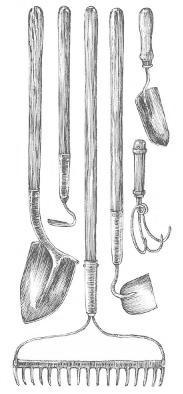 Most of the work of growing a good crop of beans (and all other vegetables, too) comes before you put the seeds in the ground. If you get your soil into the best possible shape and prepare a smooth seedbed, you'll have the fewest problems.
Most of the work of growing a good crop of beans (and all other vegetables, too) comes before you put the seeds in the ground. If you get your soil into the best possible shape and prepare a smooth seedbed, you'll have the fewest problems.
To get beans off to a good start, till or spade a sunny section of your garden to a depth of six to eight inches, making sure the soil is as free as possible of clumps of earth or sod. A seed-bed of deep, loose soil allows bean roots to stretch rapidly and to take in water, food and oxygen easily. For best germination, wait until the soil temperature is at least 60oF to plant.
To get a jump on the weeds, work the soil two or three times over a period of several days before planting (the more, the better). Each time you do this, you'll kill a lot of weeds that have just begun to germinate. Till one last time just before planting. Working the soil this way takes care of half your weeding chores before you even plant!
Best SoilsMost beans aren't too choosy about where they'll sink their roots. They'll give you a good crop in soil that's loamy, sandy, rocky, rich or poor and even in clay. But avoid planting beans in the shade or in soil that stays wet and doesn't drain well. Bean diseases thrive in wet conditions, and the roots may not get enough oxygen with water and mud clogging their air channels.
Fertility NeedsBeans like soil that's slightly acid, with the best pH range for them around 6.0 to 6.5 (pH is an acid-to-alkaline scale). They'll grow outside that range, but they make best use of the nutrients and fertilizers in the soil when the pH is slightly acid. If you're unsure about your garden soil's pH, you can purchase an inexpensive, easy-to-use pH test kit. Or, contact your local county extension agent, who can advise you about soil testing. The test will tell you how much lime (to neutralize an acid soil) or sulfur (to correct an alkaline soil) to add. If you have to add lime or sulfur, mix it into the top six to eight inches of soil. Although you can add it anytime, the fall is best because it takes time for the lime or sulfur to work.
 Victory Seed Company has all the seeds you want for your best garden in 2024.
Victory Seed Company has all the seeds you want for your best garden in 2024.
For 25 years, the family-owned Victory Seed Company has provided the highest quality vegetable, herb and flower seeds to families across the country. We are passionate about providing you the best seeds available that give excellent germination, robust plants, and the harvest you want. With a catalog of over a thousand varieties, we have everything, and our prices are the kinds that we'd want to pay. We have hundreds of yesterday's heirloom vegetables, as well as today's award winning hybrid selections. Get to know us by visiting our website and browsing through our online vegetable seed catalog.
| 1. Bush & Pole Bean Varieties |
| 2. Bean Essentials |
| 3. How Beans Grow |
| 4. Soybeans & Southern Peas |
| 5. Soil Preparation for Beans ← you're on this article right now |
| 6. Buying Bean Seeds |
| 1. Bush & Pole Bean Varieties |
| 2. Bean Essentials |
| 3. How Beans Grow |
| 4. Soybeans & Southern Peas |
| 5. Soil Preparation for Beans ← you're on this article right now |
| 6. Buying Bean Seeds |